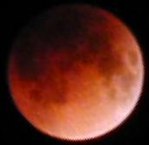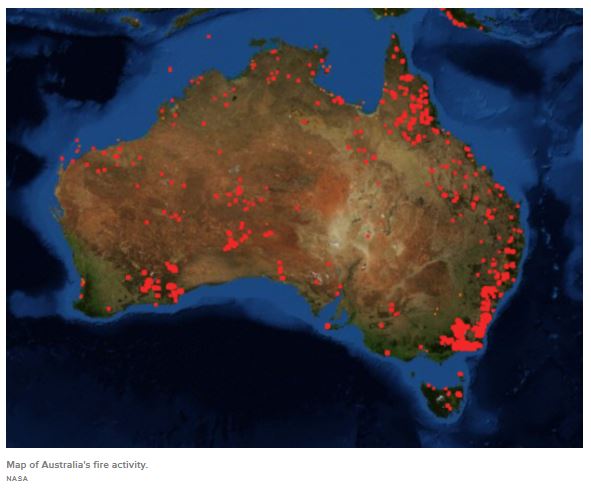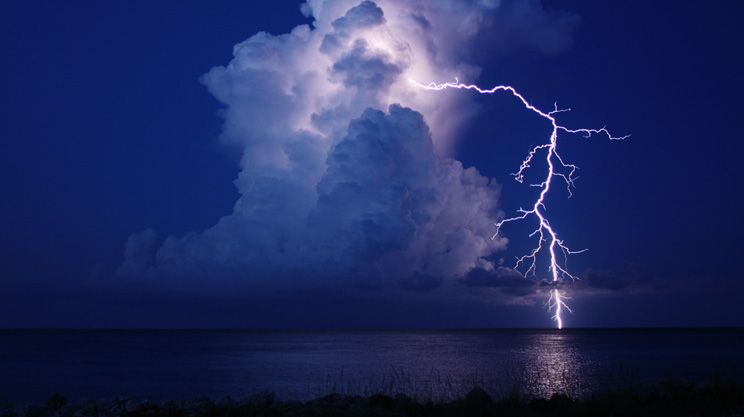
[Image credit: Peter Smith- Haifa, Israel – CC BY 2.0
The last eclipse occurring in 2020 is a total solar eclipse on December 14 with the maximum eclipse happening at 11:13 AM (EST) and will be visible only from most of South American, south-west Africa, and parts of Antarctica.
While the visibility of an eclipse can vary depending on the regions of the planet it crosses and time of day, the energetic impacts as outlined by astrology are not restricted to those areas. Astrologers generally interpret eclipses as harbingers of change that can be rather dramatic when it comes to the shifts they precipitate.
Today’s lunar eclipse occurred in the sign of Gemini, which could help to highlight the ability to recognize flaws within social structures that relate to communication and transportation. The eclipse could also help to initialize an emphasis on hard facts to back up claims being made, and a move away from idealized or romanticized notions.
On an individual level, the impacts of any eclipse must be weighed against a person’s own astrological chart to fully understand the implications.
Jupiter-Saturn Conjunction
Another celestial event for December is Jupiter and Saturn crossing paths and coming within 0.1 degrees of each other on Winter Solstice, which falls on December 21 this year. According to astronomers (not be confused with astrologers), the meeting of the two largest planets within our solar system is called a “great conjunction.”
Every 20 years Jupiter and Saturn are conjunct each other, the last occasion was in 2000. This is the closest the two planets have been in their cycle of conjunctions since 1623 but the planets trailed the sun very closely and were viewable only briefly after sunset. Prior to that, the only other closest conjunction that was observable likely occurred in 1223.
Jupiter and Saturn are easily viewable in the night sky currently, so their progress to their close union can be tracked nightly for those who are avid stargazers.
The next “great conjunction” will not happen again until 2080.
One other celestial event occurred yesterday, a meteorite created an extremely bright display as it entered the atmosphere over Japan and was captured on video by multiple cameras:
* * *
 SYDNEY – Australia released its annual State of the Climate report for 2020 earlier this month. The report notes the continued decrease in rainfall that ranges from 12 – 20% depending on region and time of year, which has resulted in drought and left the country more vulnerable to extreme fires weather like what the country experienced in 2019-20.
SYDNEY – Australia released its annual State of the Climate report for 2020 earlier this month. The report notes the continued decrease in rainfall that ranges from 12 – 20% depending on region and time of year, which has resulted in drought and left the country more vulnerable to extreme fires weather like what the country experienced in 2019-20.
The report also cites the continued drop in the number of tropical cyclones since 1982, and an increase in both ocean temperature and acidity, as well as the rising of sea levels which continue to impact coastal communities.
Globally, the report notes the continued increase in greenhouse gases, which have reached 508 ppm, the highest ever recorded. The report highlights that these higher numbers are despite the decreased use of fossil fuel emissions during the various pandemic shutdowns. There has also been an average increase of 1°C (1.8°F) of the air over the Earth’s surface temperature since 1850 and reliable records began being kept.
There have also been notable global rises in sea levels, about 25 cm (9.8 inches) since 1880 and they continue to do so at an accelerated rate.
The report forecasts continued shifts towards more extreme weather events, like drought and fire as rainfall and cooler weather periods drop in amounts, as well as an increased rise in sea levels and acidity.
* * *
 STRASBOURG, France – In other climate news, the European Court of Human Rights (ECHR) in response to a lawsuit filed by six young climate activists all from Portugal naming 33 countries, has told the governments of those countries they must “promptly respond” to the filing and that the ECHR had given it priority status due to the “importance and urgency of the issues raised.” The countries cited include Germany, France, the U.K., Russia, Greece, and Portugal.
STRASBOURG, France – In other climate news, the European Court of Human Rights (ECHR) in response to a lawsuit filed by six young climate activists all from Portugal naming 33 countries, has told the governments of those countries they must “promptly respond” to the filing and that the ECHR had given it priority status due to the “importance and urgency of the issues raised.” The countries cited include Germany, France, the U.K., Russia, Greece, and Portugal.
The suit, which could end up being a landmark ruling depending on the outcome, focuses on the failure of the countries to enact policies that will reduce the amount of emission to meet the requirements of the Paris Climate Accord which seeks to reduce the global temperature by 2.7°F (1.5°C).
The striking thing about this particular case compared to the many of the climate cases being brought, many also by young people is the approach of using human rights as an argument. The youngsters allege that the rising threat of climate change poses not just a risk to their mental and physical well being, but also their right to life, a home, and to family. The suit also cites discrimination based on age and is supported by the Global Legal Action Network (GLAN).
“It’s clearly not the case that young people are the only people vulnerable to the effects of climate change,” explained Gerry Liston, legal officer at GLAN. “But because they stand to endure the worst impacts, we’re saying the effects of failing to adequately address greenhouse gas emissions amounts to unlawful discrimination on the grounds of age.”
* * *

London Bridge [Wikimedia
Adoo-Kissi-Debrah died in 2013 which was initially ruled as acute respiratory failure resulting from a severe asthma attack in 2014. She had been hospitalized more than 30 times over the course of three years for asthma attacks. The results of that ruling were overturned in 2019, highlighting a 2018 report on the impacts and risks of air pollution.
British air pollution expert, Professor Stephen Holgate, noted in 2018 that there was a “striking link” between Ella’s emergency hospitalizations and the recorded peaks of nitrogen dioxide (NO2) and airborne particles, which are considered some of the most harmful pollutants.
The new inquiry will examine the levels of pollution that Adoo-Kissi-Debrah was exposed to and try to determine if the levels were high enough to have caused her death. If the coroner responsible for the findings determine that pollution was the cause of death, it would set precedent.
In other news:
- The 16th annual Yule Advent Solstice Sun Wheel Circle facilitated by Beth Owl’s Daughter began on Sunday and will continue through to the Winter Solstice on December 21. The focus of the ritual is to promote connection and unity, gratitude, and sacred observance of the turning of the wheel to the Winter Solstice. The simple ritual which utilizes a wreath and five candles is open to anyone of any path or belief, and even if one of the Sundays have been missed, the candles can be lit in accordance with the week of the cycle.
- A peregrine falcon that was a research bird belonging to the University of Helsinki in Finland, was shot down near Ofagbe in the Delta State of Nigeria. According to various reports on social media, the unidentified villagers who killed the bird believed it was a “witch” and only realized their mistake after they discovered it was banded with “Museum 200L Helsinki Finland.”
- 68 arrow shafts, some with arrowheads attached dating to wide a range–from 4100 B.C.E. to C.E. 1300 have been discovered by researchers in Jotunheimen, Norway. The area in southern Norway has only recently been accessible due to the continued rise in global temperatures causing the ice that encased the area to melt. Researchers from the Universities of Cambridge, Oslo and Bergen also found a variety of other artifacts which included a 3000-year-old shoe, and textiles that may have been used to wrap meat since the area would have been a prime hunting ground. Several arrow shafts found still had the twine and tar used to secure the arrowhead attached. The ice that melted revealing the finds had perfectly preserved the artifacts.
- In odd news, a monolith that was reminiscent of the one in “2001: A Space Odyssey” was discovered on land belonging to Utah’s Bureau of Land Management (BLM) less than two weeks ago, has now been removed. The monolith’s disappearance is as mysterious as its appearance. The Utah BLM said it was not responsible for its removal and had also deliberately not published the location of the monolith to discourage curiosity seekers from trying to locate it. A new similar monument has reportedly surfaced in Romania.
Tarot of the week by Star Bustamonte
 Deck: Bleu Cat Tarot, by Beth Seilonen, published by Schiffer Publishing, Ltd.
Deck: Bleu Cat Tarot, by Beth Seilonen, published by Schiffer Publishing, Ltd.
Card: Seven (7) Plants
This week may require a focus on boundaries and necessitate a drawing of lines individuals are unwilling to cross in order to meet expectations and fulfill desires. Conversely, failure to establish limits can hamper progress and allow interference from others.
Decks generously provided by Asheville Raven & Crone.
The Wild Hunt is not responsible for links to external content.
To join a conversation on this post:
Visit our The Wild Hunt subreddit! Point your favorite browser to https://www.reddit.com/r/The_Wild_Hunt_News/, then click “JOIN”. Make sure to click the bell, too, to be notified of new articles posted to our subreddit.
